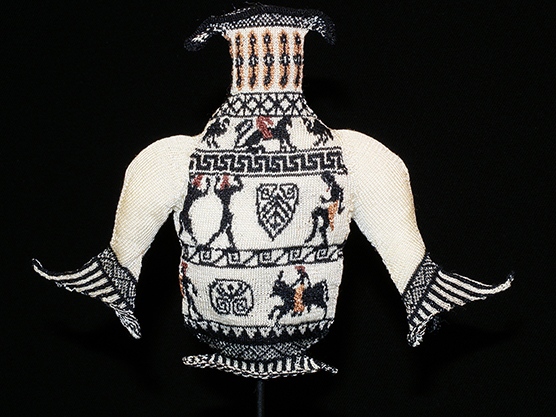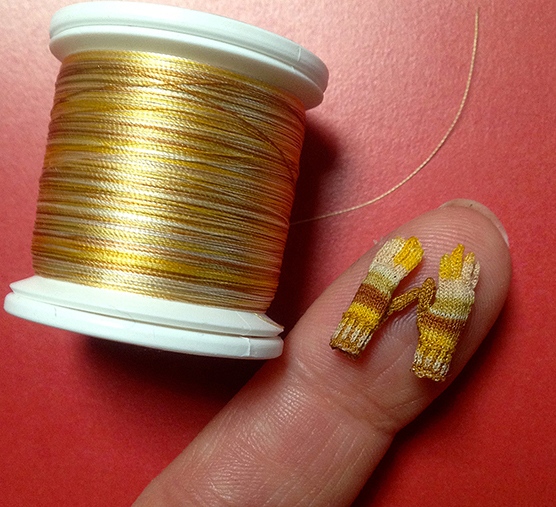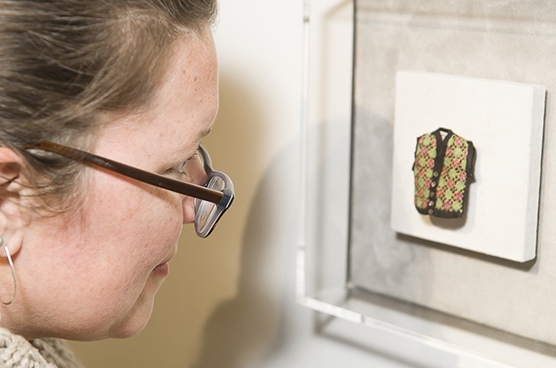
Installation view of Althea Crome’s “King and Queen of Hearts Coronation Sweater,” 2015. On view in “Pocket Museum” at Houston Center for Contemporary Craft through March 18, 2017. Photo by Scott Cartwright.
In honor of Women’s History Month, Houston Center for Contemporary Craft (HCCC) is participating in #5womenartists, a national campaign led by The National Museum of Women in the Arts to share information about women artists. Check out other entries on our blog.
This week, HCCC Curatorial Fellow Sarah Darro asked Althea Crome a few questions about the processes and inspiration behind her work. Althea is featured in Pocket Museum, which is on view in HCCC’s Artist Hall through March 18, 2017.
Sarah Darro: A number of your pieces incorporate figurative subjects and narrative elements from the art historical canon, ranging from ancient Greek amphora to Picasso paintings. You have also collaborated on projects in which characters wear your designs: the 2009 stop-motion film, Coraline, for instance. How does narrative function in your work?
Althea Crome: Storytelling started with my four children who, as they were growing up, begged me to tell them tales. It has evolved over time into storytelling in my artwork. All of my pictorial knitting tells a story—either through a single piece or through a series of work. Some of my pieces have an autobiographical theme, like my Scuba Cardigan, which I created during a time in my life when I was my most heartbroken and found it difficult to knit. I was newly divorced and looking for ways to find meaning in my life, so I took up scuba diving. The sweater tells a story of one wonderful day of scuba diving, when we were followed out to sea by dolphins, saw a rainbow and a water spout, swam with sharks and sea turtles, and I even lost and later found my weight belt in a coral reef. I used techniques on the collar and borders to create the illusion of water and sea life. The creation of this particular piece paid homage to the things in my life that helped save my spirit and, in the process, re-energized my desire to knit.
The Art History series was created during the last several years of my marriage, because my husband was an art historian, and these were the images that filled our home and our consciousness at the time. My very first pictorial piece entitled, Earth to Sky, was inspired by Lucas Cranach’s painting, The Golden Age, in which naked people frolic in a garden with fruit trees. My next piece was an homage piece to Picasso; Lady in a Yellow Hat is on the back panel with a bullfighting border scene beneath it. On the front, two Picasso owl etchings perch atop inset pockets. I went on to create another homage piece to Andy Warhol with the iconic screen-printed images of Marilyn Monroe on the back and the soup cans in the front—the lids of the soup cans open up into pockets.



My Ancient Egyptian Cardigan depicts many of the treasures and wall paintings from King Tut’s tomb; there is a secret message written in hieroglyphs on the front panels. My Ancient Greek Amphora piece not only depicts scenes one would see on an ancient Greek vase but is also designed to mimic the shape of a vase.
I also began a series inspired by Asian art because I spent some of my childhood living in Japan, and I love the art from that region. My Truth and Wisdom Kimono has an interpretation of an Edo-period samurai on the back, and the words “Truth” and “Wisdom” written in Japanese on the front. The Crane Sweater was another piece where I took liberties with the shape—knitting feather-like lace to create winged sleeves and a long, crane-like neck.
SD: How do traditional fiber-art practices inform your process, and how do you define conceptual knitting?
AC: One of the largest influences on my own aesthetic and conceptual bent is medieval tapestries like The Lady and the Unicorn and the Apocalypse tapestries. These works tell stories and incorporate symbolism. For example, The Lady and the Unicorn uses symbols to represent human experiences, emotions, and senses, while the Apocalypse tapestries form a vast narrative of the apocalypse as interpreted by Saint John the Divine in the Book of Revelations. I love the license an artist can take with symbolism; it can be fantastic, magical, eerie, and open to interpretation or very literal.
I am fascinated by historical processes. First, a concept is hatched; then, images are drawn to represent the written or spoken word, and, from these drawings, a chart is created. From these charts, many colors of threads are chosen and woven, stitched or knitted together to create the image. This process, from concept to creation, is very much how I operate. A vision will come to me in the shower or while falling asleep. I then draw it out, chart it, make a paper model, select colored threads, and, finally, knit it. I always say that, if I can design it, I can knit it.
One of the main differences between my knitted garments and a two-dimensional piece like a tapestry or rug is that a pictorial garment cannot be viewed in its entirety without turning it around. It has sleeves, front and back panels, and pockets, which all have to be viewed from different angles. I love the idea that a viewer must rotate the piece or walk around it to get the full story. This movement of the eyes or body creates a bit of animation or movement in my work that brings the story I am telling to life.


SD: Instagram accounts like the Daily Miniature (@dailymini) boast over 100,000 followers. Why do you think Internet culture, beyond dedicated miniaturists, has found such fascination with the miniature form?
AC: Certainly the concept of miniatures is not new, but the purpose of them is definitely evolving. Practical purposes for miniatures could be seen more than 4,000 years ago in ancient Egypt with the creation of funerary models and figurines that were buried with the dead. These miniatures served as guardians to look over the deceased in the afterlife. In the 18th Century, if you were a family of means, you might have a spectacular dollhouse in your home to teach your daughter the proper ways to keep a house. In the mid-late 20th Century, miniature makers began creating highly detailed replicas of historic furniture and household items, not for any practical purpose, but just because they could.
Pure miniaturists feel very strongly that everything they create must work as the original: drawers must be dovetailed, keys must turn locks that work, buttons must be button-able. In other words, if you were six inches tall, you should be able to use anything that a true miniaturist makes. It turned out that, not only did people love these fine-scale miniatures, but some were willing to pay a lot of money to own them. Museums were built just to hold many of these collections–The National Museum of Toys and Miniatures in Kansas City, Kansas, and The Kentucky Gateway Museum Center in Maysville, Kentucky, to name a few.
In the 21st Century, we have begun to see miniatures make their way, more and more, into the mainstream contemporary art scene with artists like Thomas Doyle and his apocalyptic, yet playful dioramas and Joe Fig and his exploration of artists’ studios and processes through miniature-room boxes. So, why do we love miniatures so much? Is it the cuteness factor? Is it the ability to enter a magical dimension, if only for a moment? Like when you peer into one of the Thorne rooms in the Art Institute of Chicago and transport yourself into a 17th-century Pennsylvania Dutch Living room. Is it marveling at how human hands could create something so perfect and small? Is it because sometimes we just really like to have our mind blown? Whatever the case, people like Kate Unver (she began @dailymini) are spreading the word through social media and getting more and more young people interested and involved. I believe miniatures are an evolving art form, and we will see it continue to make its mark in the art world more and more.


SD: Do you have a female role model that has inspired you and your career? If you do, how has this person influenced your life?
AC: My mother is the woman who has had the most impact on me. She started her life over again at the age of 60, reinventing herself and embarking on a life she never thought she could live. Now, in her mid-70s, she is finally happy; she’s a competitive rower, artist, gardener, homeowner, and all-around wonderful woman. She has always been a great support for me. Because she sews, she knows a great deal about threads and has helped me on more than one desperate thread quest, the most notable being finding the right thread to make Coraline’s star sweater in the movie, Coraline. Just when the studio was about to give up hope that I would find the right combination of colors and threads, my mom saved the day with her holographic thread find! My mother has not only supported my decision to give up my career as a respiratory therapist and pursue my passion as an artist, but she has shown me that, with sheer willpower, you can make anything happen for yourself, no matter what your age.

About Althea Crome
Bloomington, Indiana-based Althea Crome has pioneered knitting at a 1:12 scale. She holds the title of fellow at the International Guild of Miniature Artisans (IGMA), and her process of making what she calls “bug-knits” requires an incredible level of precision and skill. She makes her own wire knitting needles, which have a diameter of .01 inches, and uses a fine, silk sewing thread, rather than yarn, to achieve the tiny stitches that compose her works. Her needles can accommodate up to 80 stitches per inch. Taken to the silver screen, her miniature knit garments adorn the lead character of the 2009 stop-motion film, Coraline. She designs her own knitting patterns as well as adapts traditional patterns.
